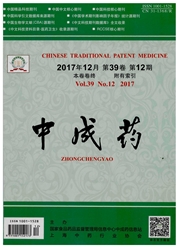

 中文摘要:
中文摘要:
目的研究盐巴戟补肾壮阳作用增强的药效机制。方法采用甲巯咪唑灌胃给药的方法复制阳虚内寒证大鼠模型,以右归丸为阳性对照,分别给予模型大鼠巴戟肉、盐巴戟的高、中、低剂量的水煎液。测定大鼠血清游离三碘甲状腺原氨酸(FT3)、血清游离四碘甲状腺原氨酸(FT4)、血清促甲状腺素(TSH)、下丘脑促甲状腺素释放激素(TRH)、血清一氧化氮(NO)、血浆环磷酸腺苷(c AMP)、血浆环磷酸鸟苷(c GMP)和c AMP/c GMP值,并作甲状腺病理学检查。结果巴戟肉和盐巴戟均可以改善大鼠甲状腺功能低下的症状,其中盐巴戟的治疗效果最为显著,较相同剂量的巴戟肉好。结论推测巴戟天补肾壮阳作用可能与调节大鼠的下丘脑-垂体-甲状腺轴功能有关。
 英文摘要:
英文摘要:
AIM To compare the effects of salt- and nonsalt-processing Morinda officinalis on rats with kidney Yang deficiency. METHODS The rat models for the kidney Yang deficiency were made through the perfusion of methimazole. The modeled rats were treated with high-,middle-,low- dose of water-extract of salt-processing M.officinalis and nonsalt-processing M. officinalis; Yougui Pills were used as a positive control. The activity of serum free three triiodothyronine( FT3),serum free four triiodothyronine( FT4),serum thyrotropin( TSH),hypothalamic thyrotropin-releasing hormone( TRH),serum nitric oxide( NO),plasma cyclic adenosine monophosphate( c AMP),plasma cyclic guanosine monophosphate( c GMP) and c AMP/c GMP values and thyroid pathology were measured by colormetric methods. RESULTS The results showed that salt- and nonsalt-processing M. officinalis could improve thyroid dysfunction of rats. The former were better than the latter at the same concentration.CONCLUSIONS The rational speculation encourages that M. officinalis regulates the hypothalamus-pituitary-thyroid axis function,invigorates the kidney and strengthens Yang.
 同期刊论文项目
同期刊论文项目
 同项目期刊论文
同项目期刊论文
 期刊信息
期刊信息
